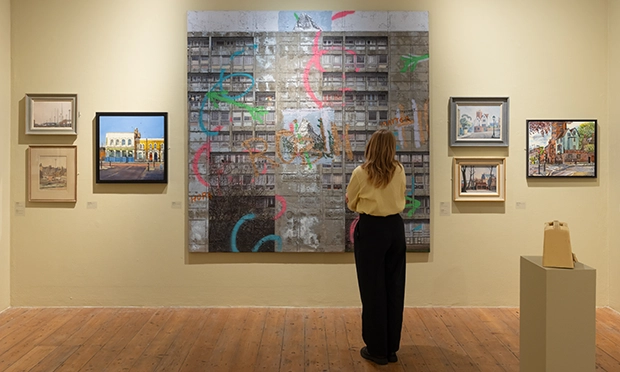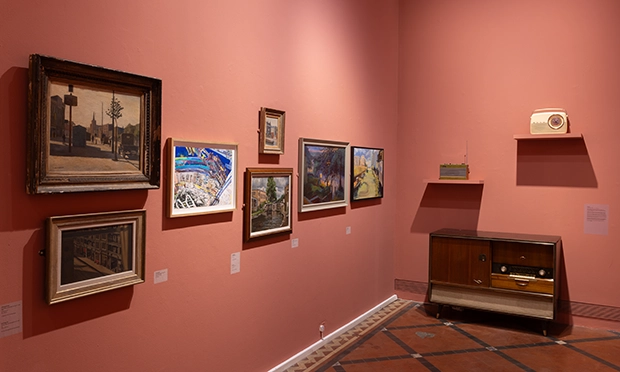In the Footsteps of the East London Group, Nunnery Gallery, exhibition review: ‘A fascinating collection’

‘Contrast immediately strikes us’: Installation view of the exhibition. Photograph: Bow Arts
An enthralling new project led by the Urban Contemporaries Group reflects on how artists have connected over time with the spaces around them.
Since becoming fashionable in the late 20th century, East London has been mined by those in the creative arts for its multicultural vibe and post-industrial aesthetic.
But for earlier generations, it was simply a place to live and work.
Among its denizens were the East London Group of painters, trained in the 1920s and 1930s by Walter Sickert, John Cooper and others, who showed their work in a series of exhibitions at the Alex Reid & Lefevre Galleries.
In the Footsteps of the East London Group at the Nunnery Gallery draws together 22 contemporary paintings by David Hepner, Doreen Fletcher, Tim Craven and others to reflect on the output of the earlier artists, 35 of whose canvasses have been paired with them.
The exhibition is accompanied by a handsome hardback volume of the show.
Walter and Harold Steggles, Elwin Hawthorne, Grace Oscroft, Albert Turpin, Henry Silk and 27 others had day jobs as tradesmen, craftsmen, clerks and housewives; in their spare time they painted their surroundings.
Their latter-day counterparts are professional artists, many with highly prestigious accolades under their belts.
Both groups have been drawn to the area stretching from Canonbury in the west to Stratford in the east, passing through Bethnal Green, Bow, central Hackney and Hackney Wick, and they have seen different things there.
Indeed, contrast is what immediately strikes us when viewing the collected body of work.
The contemporary paintings are bright, colourful and congested, teaming with the busy cultural mess of today’s urban landscape; the earlier pictures show empty streets and forgotten corners, almost entirely devoid of human presence.
Of course, London has changed beyond recognition in the intervening period, and so has art. But look more closely, and you can trace the continuities.

‘You can trace the continuities’: The works are on display until 22 December. Photograph: Bow Arts
Most obvious are the many buildings, bridges and other structures that remain, if seen differently by the early 21st century eye.
These include The Guardian Angels, a 1931 grey-brown painting of the eponymous Mile End church by Elwin Hawthorne in 1931, with the same building accompanied by a red bus in Frank Creber’s 2023 rendition, Plein Air Painting of Guardian Angels Church.
Walter Steggles’ 1938 view of the River Lea in Stratford has barren industrial buildings reaching down to the water; Sarah Lowe’s Wicked (2024) shows a similar scene but with graffiti, boats and people.
Freighters in West India Dock by Walter Steggles (1927) is a demure watercolour of hulking craft, waiting to be unloaded, while West India Dock (Boundary between Here and There) by Alexandra Blum (2024) is a raucous medley of colours and cultural references against the backdrop luxury waterside housing.
The artworks from the 1920s and 1930s reflect an earlier generation’s environmental sins – colours are muted and the skies dim, many with a sulphurous yellow tinge, undoubtedly accurate depictions of the air pollution of their time.
The more recent pieces boast blue skies with airplanes and clean streets bordered by cars, evoking less visible forms of pollution.
Fiona McIntyre’s neon green sludge in Bow Back Rivers Algae Bloom (2024) alludes to how we are now tainting our water.
In another sense, the strands connecting the two bodies of work are conceptual; Walter Steggles’s mud-brown slum houses in Old Houses, Bethnal Green (1930) are echoed in David Hepner’s masterful 2023/24 painting, North Face I, of a dilapidated 1960s tower block sprayed over with graffiti.
Ferha Farooqui’s Lost Highway (2024) points to what has been lost in the time between, with bomb-destroyed buildings painted as blue ‘shadows’ where they once stood, against a backdrop of modern urban life.
Conversations across artistic generations are bound to be one-way; what would Mssrs Steggles, Elthorne, Silk and their crowd have thought of the jangling transport mish-mash of Hilary Rosen’s Bethnal Green and East India Docklands (Triptych) (2024)? Or the riot of sardine-packed life in Michael Johnson’s Cambridge Heath Road (2023)? Would they have been shocked or delighted?
We’ll never know, but rooting contemporary art in its historic context breathes new life into both parts of this fascinating collection.
In the Footsteps of the East London Group runs until 22 December at the Nunnery Gallery, 181 Bow Road, E3 2SJ.
For more information, visit bowarts.org/nunnery.
In the Footsteps of the East London Group: Reflections on the Works of the East London Group by Painters of the Contemporary Urban Landscape by Alan Waltham, Ferha Farooqui and Frank Creber is published by Batsford. ISBN: 978 184 994 9354; RRP: £20.00.
